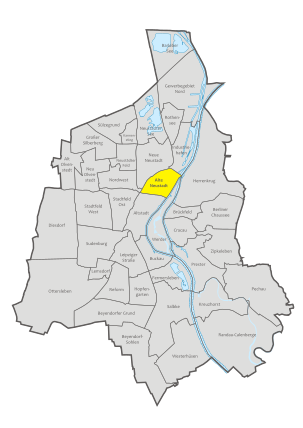Old New Town
|
Old Neustadt district of Magdeburg |
|
|---|---|
| Basic data | |
| Surface: | 2.5657 km² |
| Residents : | 11,443 |
| Population density : | 4,460 inhabitants per km² |
| (Information as of December 31, 2016) | |
| Coordinates : | 52 ° 9 ' N , 11 ° 39' E |
| Districts / Districts: | University district north front Nordpark Hohepfortestrasse Neustädter Bahnhof |
| Postal code : | 39106 |
| Tram lines : | 1 2 5 8 9 10 |
| Bus routes : | 69 73 610 613 ( BördeBus ) 704 ( NJL ) |

The Alte Neustadt is a district of the state capital Magdeburg of Saxony-Anhalt . 11,443 people live in an area of 2.5657 km² (as of December 31, 2016).
history
In 1209 this city was first called "civitas nova" (new city) in the report on the conflict between Emperor Otto IV. And Archbishop Albrecht I mentioned - the New Town as well as the village Frose were completely destroyed and were north Old Town rebuilt .
With the foundation of the Agnetenkloster by Albrecht I in 1230 the Neustadt received city rights (not as a suburb of Magdeburg, but as an independent city), in 1373 Frohse was included. The ramparts and fortifications of the old town, which were expanded again and again, made it necessary to move further north, which meant that old buildings were lost.
The Schwiesau Hospital was founded in 1471 and existed in Alte Neustadt for more than three hundred years.
The capture of the (old) Neustadt by troops of Elector Moritz von Sachsen on November 28, 1550 and Duke Georg zu Mecklenburg in the course of the siege of the city of Magdeburg to enforce an imperial ban (the siege ended on November 5, 1551 ), as well as in The Thirty Years' War on April 21, 1631 led to the evacuation and destruction of the Alte Neustadt (by Magdeburg troops on the orders of Dietrich von Falkenberg ; this was to prevent Neustadt from falling into his hands if Tilly was inevitably captured ).
After the reconstruction, at the end of the 17th century it stretched from what is now Pfälzer Platz to Sieverstor . Since 1680, the then still independent town of Neustadt belonged to the Brandenburg-Prussian Duchy of Magdeburg and was located in what was then Holzkreis II.
The main forms of employment were agriculture and trade. Distilleries, breweries, chicory arrows and cloth processing already settled here before 1800 .
On the orders of Napoleon I , most of the Old New Town was demolished in 1812 in order to build fortifications and their strategic surroundings. As a replacement, the New Neustadt was founded on the road to Barleben . The Agnetenkloster and Schwiesau Hospital were also destroyed in this context.
The Alte Neustadt originally belonged to the city of Neustadt-Magdeburg and was incorporated into the city of Magdeburg on April 1, 1886.
The construction of the commercial port on the Agneswerder from 1886 to 1893 was of decisive importance for the settlement of new industrial plants (mill works, coffee factory - today: Röstfein -) and warehouses and silos.
From 1898 the construction of the Martinskirche took place . In World War II heavily damaged, the building was blown 1959th
Buildings, plants and facilities
The cultural monuments in the district are listed in the local monument register .
The following special facilities should be mentioned:
- Börde brewery (closed)
- Fire station north
- Fraunhofer Institute for Factory Operation and Automation
- Geschwister-Scholl-Park , formerly "Queen Luise Garden"
- Lift bridge in the Magdeburg trading port , built in 1894, technical monument
- Old Neustadt engine shed
- Max Planck Institute for Dynamics of Complex Technical Systems
- Nordpark , former north cemetery of the city of Magdeburg
- Otto-von-Guericke University Magdeburg
- Röstfein Kaffee GmbH
- Full portal crane in the Magdeburg trading port , technical monument
- Werner-von-Siemens high school
people
- Mayor:
- 1681–1690: Martin Sievers
- 1811–1846: Karl Rosenthal
- City Councilor:
- 1878–1886: Johann Wilhelm Hauswaldt
- People who are otherwise connected to the Alte Neustadt:
- Berthold Schwiesau founded the Schwiesau Hospital in 1471 .
- Maria Kühne (1885–1947) was active in Alte Neustadt until 1934 in the Müller-Kühne resistance group .
- Johannes Kirsch (1891–1951) headed the illegal local group of the KPD from May 1933 to September 1935 .





